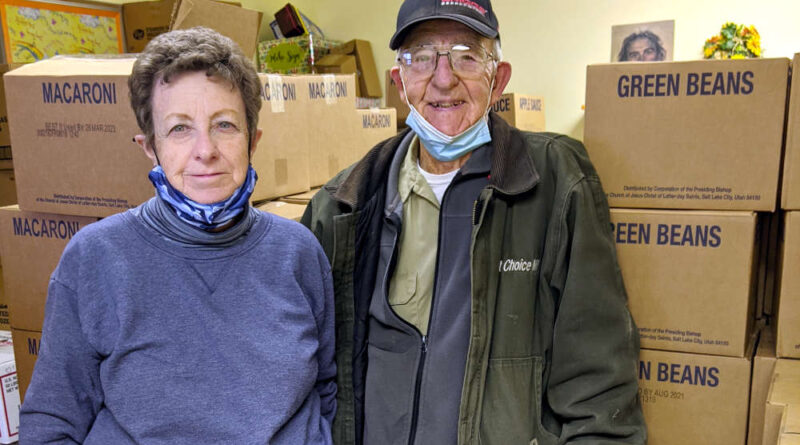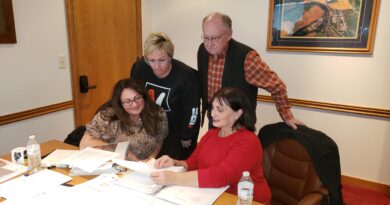Local couple devotes decades to helping others
SHELLEY — When it comes to being social influencers, few have influenced the community of Shelley and Firth more than one local couple, Leon and Beverly Peeler. Though they don’t have much of a presence on social medial, the couple has been influencing lives for the better since the early 1990s at the foodbank in Shelley. Together, they have more than 50 years of service.
The Giving Tree
Beverly is the current director of the North Bingham County Community Foodbank, located at 180 South Holmes Avenue in Shelley. She started as a volunteer around 1996, when she and Heidi Schultz, decided to help needy children by providing a way to get gifts for them at Christmas time. They called it the Angel Tree.
The duo put up a tree at King’s Department Store and hung angel-shaped tags containing the names of those in need. Those interested in helping chose a tag from the tree. Originally, they were given a little bag in which to include something warm, something to read, and something fun. The two wrapped all the gifts themselves.
Soon, then Foodbank Director, Sally Hartert changed the program to allow the tags to list a specific need, like snow boots or pajamas, as well as size and gender.
Peeler stuck with it every year, even when there were nearly 200 people in the program, including senior citizens who were often overlooked during the holidays.
“It’s always been my passion,†she said.
She enlisted more helpers and people started donating money to the Angel Tree and continue to. The Girls Scouts and families helped out with gift-wrapping. The local police department donated unclaimed bikes that they gathered throughout the year and Bill’s Bike Shop in Idaho Falls did the repairs and tune-ups.
Every pew in the Methodist Church was filled with large black garbage bags of gifts ready when the Christmas food boxes were distributed.
The Angel Tree has continued on over the years. This year, the Angel Tree is located in the Shelley Broulim’s store.
Becoming part of the foodbank
Gradually, Beverly became a fixture at the foodbank and learned the ins and outs of the non-profit. She learned bookkeeping, grant-writing and logistics of distribution. When Hartert’s health declined, she trained Beverly to take the director’s position.
Leon Peeler started volunteering at the foodbank even earlier than Beverly. After he retired from cabinet making in 2003, he took it on almost as a full-time job.
RELATED: Here’s what’s happening with the Community Foodbank
The foodbank began as an outreach from the Shelley Community United Methodist Church. Three members, Dorothy Snarr, Phyllis Taylor, and Frieda Leatham began trying to help a handful of families find the food they needed in about 1994. The church served as a sponsor when the foodbank was established as a nonprofit organization and continues in that role. But by next July, the church will close its doors.
Pastor Davey Leffler died last year and the search for a new pastor has been unsuccessful. As for the congregation, the Peelers are the last of only a few worshipers, who haven’t had services since the pandemic began in March. The church has been in Shelley for well over 100 years.
The pandemic has also impacted operations at the foodbank. Clients now drive up to the curb to receive food on Tuesdays between 11 a.m. and 1 p.m. The foodbank continues to serve about 40 families per week, although 89 families have signed up for holiday boxes. Rather than registering for help in person, clients registered by mail for the upcoming year.
“This change has worked beautifully,†Beverly said. “We called the food pantry in Blackfoot and they told us how they make the curbside delivery work. Now only a few masked volunteers are in the foodbank to allow for social distancing and clients stay outside.
Surprisingly, not as many clients are seeking help recently as in years past. Peeler said when federal stimulus checks arrived and benefits increased for unemployment and food stamps, fewer people came to the foodbank in Shelley, while numbers increased in Blackfoot and Idaho Falls food pantries.
“I hope that means that they are doing better financially,†Beverly said. “People don’t like to come if they can do it on their own, but we are here. If you need help, we are here. Nobody is ever turned away.â€
What it takes to run the foodbank
“People don’t realize all that goes into making this place work,†Leon said.
Beverly said Leon “hustles†all the time, trying to find donations, boxes for the donations, and managing the food that comes in and goes out. He built lots of banks of shelves in the house next door to the church and has remodeled it several times.
A community food drive in October, formerly known as Scouting for Food, brought in more than 15,600 pounds of food and a Woodville ward brought in another 800 pounds in November. Additionally, students in Firth conducted a food drive and donated 3,000 pounds of food. East Idaho Credit Union donated $3,600 prior to Thanksgiving.
“We almost have run out of places to put it,†Leon said.
He showed that one room was completely full of donations given by The Church of Jesus Christ of Latter-day Saints as part of Covid-19 relief distributed in locations world-wide.
“We’re grateful for the help we’ve received from many organizations,†Beverly said. “Whenever our shelves are nearly bare, help always comes. We do this because we simply care. That’s why most people volunteer. It’s better than getting paid. Nobody can do this alone. We just thank everyone who has helped us through the years.â€






Comments are closed.